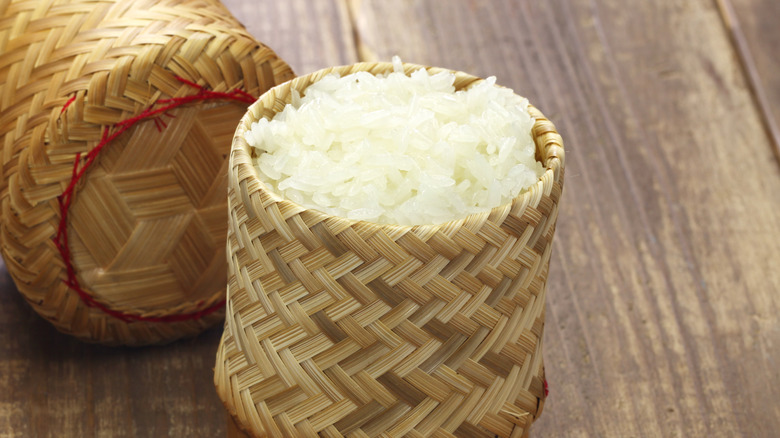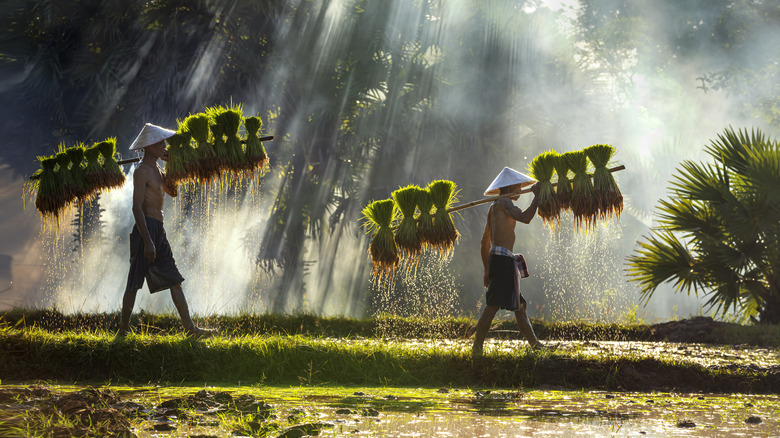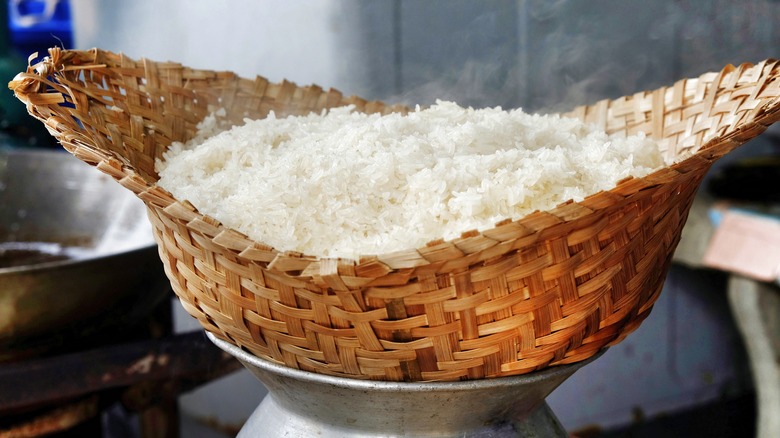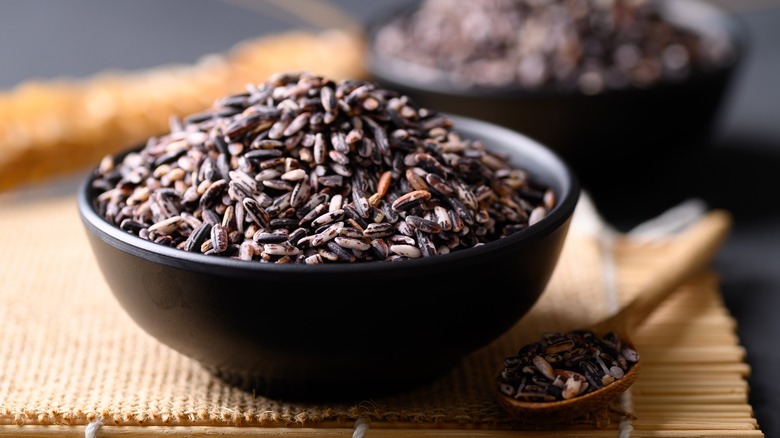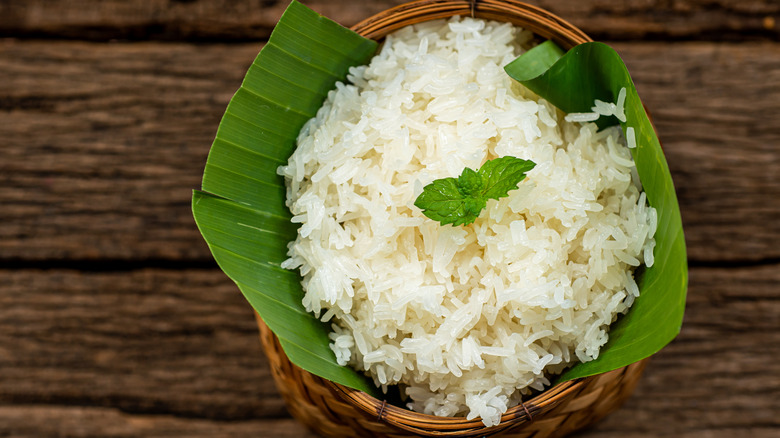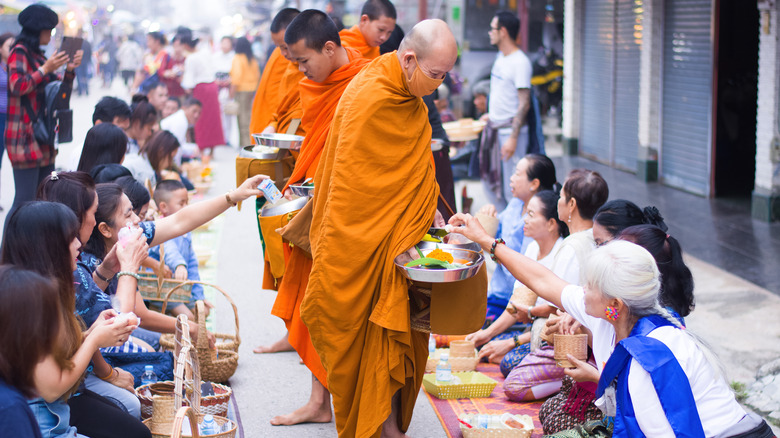What Makes Sticky Rice Unique?
We may receive a commission on purchases made from links.
For many people living on our planet — more than 3.5 billion, to be precise (per National Geographic) — rice, such as sticky rice, is a staple food, notably in Asia, Latin America, and some areas of Africa. There are an impressive number of varieties of this popular grain out there as well. Bon Appétit reports that there are a staggering 40,000 types of rice that exist. If you want to get started on tasting all of them, you'll want to consult our handy guide on 15 types of rice and how to cook them.
After all, nobody likes undercooked, soggy, or wet rice. And please, if you ever find yourself draining rice, you have probably added too much water. Many types of rice, like basmati, are tastier when cooked so that the grains are fluffier. However, sticky rice should be anything but fluffy, as it's known for its chewy texture. It goes by the name glutinous rice, or "oryza sativa var. glutinosa" (per Advances in Agriculture and Food Research Journal), and has "an opaque and small size grain cultivar distinct from common white rice."
What is sticky rice? And what's its history?
For the past 4,000 years, sticky rice has been cultivated in Southeast Asia, though it is unclear whether or not the crop was favored out of circumstance or preference. According to Smithsonian Magazine, historians are split on whether sticky rice was grown by people in the past because it grew well in the area or because it was enjoyed by locals. Either way, sticky rice, not the classic white rice, became the dominant food staple in that region, with the craze for sticky rice concentrating in Laos, where the "per-capita sticky rice consumption is the highest on earth at more than 345 pounds per year." The top traditional food in Laos is khao niew, sticky rice steamed in a bamboo basket and served with most Laotian dishes (via Experience Travel Group).
Per Food Navigator, one study from 2002 found that sticky rice is the result of a genetic mutation. Regular rice has two starches, amylose and amylopectin, but the lack of amylose in glutinous rice is what makes the rice so sticky. The resulting texture of sticky rice is far chewier than normal rice. As Cooking With Lane explained, sticky rice tastes rather plain, so it's often served as part of a dish rather than as the main component of the meal.
How to make sticky rice
The key to making sticky rice is time. The glutinous rice grains first must be rinsed until the water runs clear and then be soaked in cold water from at least two hours. Sometimes the rice should be soaked up to an entire day, per one New York Times Cooking recipe.
From there, preparing sticky rice is about what kitchen tools you have at your disposal. You can make it in a rice cooker, but a steamer is best for sticky rice. The simplest way is to use a pot of boiling water and a colander: You'll take the soaked glutinous rice, drain it, steam the rice covered for around 15 minutes and then for another 10 minutes with the rice flipped over, tasting for texture before you remove the rice from the heat.
However, to make Laotian style sticky rice, you'll need a sticky rice steamer pot and bamboo basket. The rice will still need to be soaked overnight in cold water. The following day, you will bring water to a boil in the pot, and then place the rice in the bamboo basket while ensuring the water is not touching the basket. Let the rice cook for 15 minutes, and then flip the rice with the basket "like you would flip an omelette," International Cuisine explained. "In one swift movement." After another five minutes, the sticky rice should be ready to serve, either in individual bamboo baskets or in the plating of your choice.
Other varieties of sticky rice and where to buy them
According to Open Access Government, Thailand is the world's biggest producer of sticky rice, and there are three groups of sticky rice divided by grain size: "small (japonica), medium (upland), and long slender (indica) grains." A common small grain sticky rice is Japanese sweet rice, while Thai sticky rice is a longer grain. Black and purple sticky rice is a whole grain variety, per Easy Thai Kitchen. Purple sticky rice dates back to 2500 B.C. and comes from Japanese rice. It is black when raw and turns into a distinctive purple color when cooked, which is likely a result of a mutated gene (via Healthline).
Sticky rice is widely available for purchase. It's available nationwide at Walmart and is also easily purchased online. For example, a large, five-pound bag of Thai sticky rice is available on Amazon, as are the Japanese sweet sticky rice type and even a brown glutinous rice variety.
Nutritional information about sticky rice
For those with gluten sensitivities or celiac disease, do not be misled by the term "glutinous." Glutinous rice does not contain any gluten, and sticky rice is perfectly edible for those on a wheat-free diet, per Food Republic.
According to Organic Facts, one cup of sticky rice provides around 170 calories and is a source of protein, B vitamins, selenium, zinc, copper, magnesium, and fiber. One 2017 Japanese study has even found that consuming brown glutinous rice may help glycemic control in those with type 2 diabetes. A 2020 study showed that eating glutinous brown rice might even help prevent diabetes.
Since white rice is a staple food in Asia, those who eat it in large amounts may be more at risk for developing type 2 diabetes. To better their health, they may want to switch to brown rice, or, for those who dislike the taste of regular brown rice, they could instead eat sticky brown rice. The 2020 study posited that "glutinous brown rice (GBR) might be preferred to brown rice and could be acceptable in the daily diet."
Sticky rice is used in religious ceremonies
In Smithsonian Magazine's deep dive into the importance of sticky rice in Laotian culture, it's stated that sticky rice is used in religious ceremonies, mostly for Theravada Buddhist purposes. Adherents to this religion will prepare khao tom, a "fusion of sticky rice, coconut, banana and mung bean — for ceremonies related to plantings, rainfall, harvests and death." Monks even prefer sticky rice because it sticks in the stomach for longer — it takes more time to digest than regular rice. For blogger Saeng Douangdara, khao tom was a snack he'd eat at temple as a child, and the sticky rice treat was always made and enjoyed in an envelope of large banana leaves.
Another ceremony of communal prayers, the baci ceremony, uses raw glutinous rice to toss in the air. This baci ceremony is performed for a number of life occasions, like the birth of a child, a wedding, a homecoming, and also after funerals, according to Laos Guide 999. In China, sticky rice is used in zongzi, a type of dumpling used during the Dragon Boat Festival (per Sons of China).
